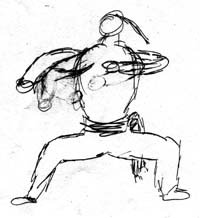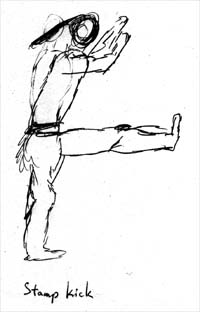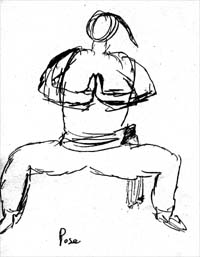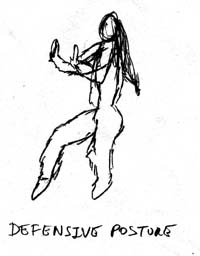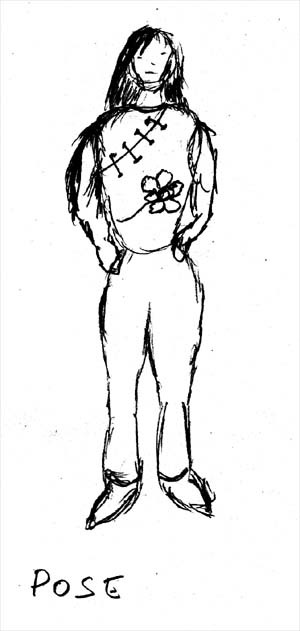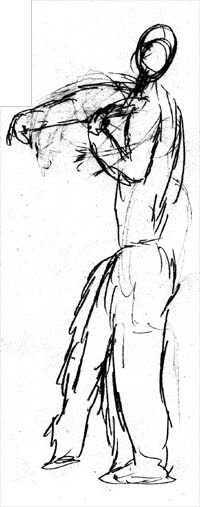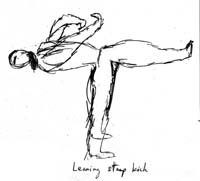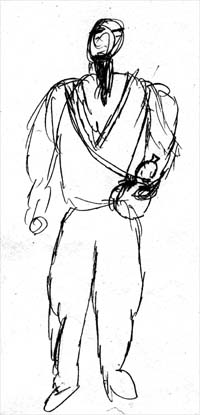Chris Pollett >
Students >
Leo
( Print
View )
[Bio]
[Del1]
[Del2]
[Del4]
Initial Game Design
Description: For this deliverable, the focus was to write down some ideas for the thesis game. A premise for the game as well as the idea for five characters have been created. Also, some conceptual sketches of what the characters may look like have been drawn. Furthermore, a payoff matrix was constructed after studying video of real-life martial arts tournaments, as well as commercial 3D fighting games. This game has been simplified to allow it to be completed within the expected time frame of the thesis, while at the same time, care has been taken to ensure the realism of the martial art moves and general fighting game play that will be employed. The full initial game design document follows.
Alpha Fighter Design Document 1
Concept
An anonymous man, who refers to himself only as Mr. X, has sponsored a secret underground fighting tournament. He has sent invitations to several of the world top fighters. In this letter, he explains that he has constructed a secret temple, which is to be used for training the most elite martial artists. He explains that he has strong roots in the martial arts, and wishes for the long forgotten days when martial arts were a way of life. The temple has been completed and he is now hosting this tournament to determine the best fighter, and new head instructor at this temple. The champion will be deemed the Alpha Fighter and will be generously rewarded.
Gameplay
Alpha Fighter is a one-player 3D fighting game. As a contestant in the tournament, the player must defeat all other fighters to be deemed the champion. The game plays similar to most 3D fighting games.
The main focus for this game is really on the A.I. of the computer controlled opponent, or non-player character (NPC). The goal is for the NPC to behave like a relatively intelligent human player. Traditionally, the NPC's would "cheat" by basing its action on the player's current input. This is analogous to looking at the opponent's hand before deciding what to do in a card game. The idea is that in a fighting game, a human player will learn from its opponent's actions and use that knowledge to learn and formulate new strategies. The A.I. system of this game takes a similar approach, by learning from the player's actions, and formulating new strategies based on those observations. By allowing the A.I. system to observe only those things that can be observed by a human player, the "cheating" in traditional A.I. game systems is eliminated.
Characters
So far, there are five characters planned for the game. This is subject to change.
- Mei Lan is an elementary school teacher by day and assassin by night. She works for a secret government organization in China, where she is assigned to eliminate criminals who are beyond the reach of regular officials or whatever reason. Her top-notch deadly skills have made her an invaluable asset, but is little known outside of a small circle of top government officials. It is peculiar how Mr. X found out about Mei Lan. She has grown tired of all the killing and dreams of a simpler life. She joins the tournament in hopes of this new life.
- Perry Johnson, called PJ by most, is an all-star overachiever in sports. He has excelled in every single sport he has ever played, from baseball, to bowling, to judo. Perry's diligence and natural athletic abilities has led him to become a legendary sports icon, as well as fame and fortune. There was no hesitation in PJ's decision to compete in the tournament, as he has never been one to turn down a challenge.
- Bear, as he likes to be called, is a Russian who likes in the harsh climate of Siberia. A giant of a man, Bear was outlawed from the Strongest Man Competition. Many thinks he must use many strength-enhancing drugs to perform the super-natural feats of strength he does. In size and power, Bear is unmatched by any mortal today or in history. When the invitation finally reached Bear in the depths of Siberia, he couldn't pass up the chance to prove once and for all, that no person can defeat the power of Bear.
- Selena Maria Perez is the toughest cowgirl in the world, and she has proven it by becoming the champion of the International Rodeo Competition for ten years running. Fighting with men in bar room fights, and wrestling with beasts out in the countryside has made Selena one of the toughest people around. She plans to win the tournament in order to prove once and for all, that a cowgirl and be tougher than any man.
- Li Fei used to be a Shaolin monk years ago. Now he is a 70 year old nomad who travels in the mountains of Asia alone, honing his skills. At the age of 30, Li Fei had become one of the greatest martial artists in the history of the Shaolin temple. However, he grew tired of the growing tourism at the temple and pleaded with the head masters to return the temple to the old way, secluded and closed to the outside. The head masters declined Li Fei's plead and Li Fei ran away a week later to find peace for himself alone. In receiving this invitation, Li Fei's dreams of having a secluded, peaceful temple to practice the martial arts was once again renewed. Although getting on in years, this old man's extensive physical and mental training puts him on par with any other fighter today, young or old.
Style
In addition to choosing a character, the player must choose a fighting style.
- Northern Shaolin focuses on kicks and fast attacks on a flexible foundation.
- Southern Shaolin focuses on a strong foundation and strong punches.
- Street fighting focuses on whatever works.
- Drunken style works on deliberately confusing the opponent, catching the opponent off guard with unpredictable behavior.
Payoff Matrix
In constructing the payoff matrix for this game, I have divided the possible moves in classifications. A move in this game can be classified by the following three attributes: target, range, and speed. Note that speed is inversely proportional to power. Range can be high or low. High indicates a strike to the neck or head, low indicates a strike anywhere else lower. Range can be long or short. Long range attacks are those reachable by the length of a fighter's extended leg, but not anything shorter. Short range is when the opponent is within striking distance of the hands. Speed is a measurement of how long it takes between the time when the fighter initiates a movement and the time when the strike lands on the opponent.
The payoff matrix has rows and columns labeled by these classifications, rather than the moves themselves. That is, this game does not distinguish between the intricate details of different moves, but rather groups them in these general categories. This was done to simplify the design and implementation of the game.
Note that a character may be able to perform a certain class of move in more than one way. That is, the character may have several moves that fall into the same class of moves. However, in the payoff matrix itself this distinction does not matter, it is the class the move is in that dictates what the payoff is.
How to Read the Matrix
The labels along the left and top indicate the classification of the move. Each cell in the matrix indicates the outcome of fighter A performing the action in that row and fighter B performing the action in that column at exactly the same time. Ax indicates fighter A caused x amount of damage on fighter B e.g. A3 means A damaged B by 3 hit points. Bx carries similar meaning but vice versa. In general, a long and fast strike causes 1 point of damage, long and slow causes 3, short and fast causes 2, and short and slow causes 5.
Attack / Attack Payoff Matrix:
| A B |
high long fast |
high long slow |
high short fast |
high short slow |
low long fast |
low long slow |
low short fast |
low short slow |
| high long fast |
A1 B1 | A1 B0 | A1 B2 | A1 B0 | A1 B1 | A1 B0 | A1 B2 | A1 B0 |
| high long slow |
A0 B1 | A3 B3 | A0 B2 | A3 B5 | A0 B1 | A3 B3 | A0 B2 | A3 B5 |
| high short fast |
A2 B1 | A2 B0 | A2 B2 | A2 B0 | A2 B1 | A2 B0 | A2 B2 | A2 B0 |
| high short slow |
A0 B1 | A5 B3 | A0 B2 | A5 B5 | A0 B1 | A5 B3 | A0 B2 | A5 B5 |
| low long fast |
A1 B1 | A0 B1 | A2 B1 | A0 B1 | A1 B1 | A0 B1 | A1 B2 | A0 B1 |
| low long slow |
A0 B1 | A3 B3 | A0 B2 | A3 B5 | A0 B1 | A3 B3 | A0 B2 | A3 B5 |
| low short fast |
A2 B1 | A2 B0 | A2 B2 | A2 B0 | A2 B1 | A2 B0 | A2 B2 | A2 B0 |
| low short slow |
A0 B1 | A5 B3 | A0 B2 | A5 B5 | A0 B1 | A5 B3 | A0 B2 | A5 B5 |
Attack / Defend Payoff Matrix:
| A B |
block high | block low | strafe left | strafe right | jump |
| high long fast |
A0 B0 | A0 B1 | A0 B0 | A0 B0 | A0 B1 |
| high long slow |
A0 B0 | A0 B3 | A0 B0 | A0 B0 | A0 B3 |
| high short fast |
A0 B0 | A0 B2 | A0 B0 | A0 B0 | A0 B2 |
| high short slow |
A0 B0 | A0 B5 | A0 B0 | A0 B0 | A0 B5 |
| low long fast |
A0 B1 | A0 B0 | A0 B0 | A0 B0 | A0 B0 |
| low long slow |
A0 B3 | A0 B0 | A0 B0 | A0 B0 | A0 B0 |
| low short fast |
A0 B2 | A0 B0 | A0 B0 | A0 B0 | A0 B0 |
| low short slow |
A0 B5 | A0 B0 | A0 B0 | A0 B0 | A0 B0 |
Means of Research
In designing the fighting mechanics of this game, I studied various existing fighting video games as well as video of martial arts tournaments, both sparring and forms competitions. It should also be noted that I've studied Shaolin gung fu for over ten years, so I am familiar with martial arts.
Early on, it was decided that I should determine classes of moves. The reasoning behind this was to prevent the complexity involved in having each move act differently. This would have lead to an exponential growth of complexity in implementation as well as time and space efficiency. In order to determine these move classes, I set out to determine the most significant attributes pertaining to a fighting move.
The first thing I did was to play a few fighting video games to get a sense of what attributes they may have used. I analyzed the fighting mechanics of the games Tekken 3, Virtual Fighter 4, and Fight Night 2004. The attributes I determined to be most crucial to a fighting move in these games were target, range, speed, and power.
The target could either be the head or the body. I realized that in boxing, hitting anything lower is illegal, while in martial arts it is not. However, target was still just as important. In hitting the head, the damage was usually higher than hitting the body. However, the advantage of hitting the body is in what some refer to as, "knocking the wind out" of the opponent. In other words, it can be an effect means to lower the opponent's stamina and mobility.
The second attribute was range. The long range attacks in the game such as the jab and straight were less damaging than the short range attacks such as the hook and uppercut. However, there were even longer ranged attacks, which caused the most damage. These were lunging attacks that left the player very vulnerable if a miss occurred. So really in effect it was a tradeoff between vulnerability and damage. If the player is very close, he is more vulnerable than further away, but can cause more damage. However, he execute a high risk move from far away, leaving him extremely vulnerable, but causing a lot of damage if the strike lands.
The third and fourth attributes were speed and power. These are opposite sides of the same coin. A quick move generally means there's little power behind it. Whereas a powerful move requires more time to accumulate the strength behind that blow. This is very evident in boxing. The power behind a jab requires little more than the momentum from stepping forward slightly on the leading foot. In contrast, a solid hook requires a "windup" before twisting the body into the hook. So I collapsed these two attributes into just speed, with the understanding and oversimplification that speed is inversely proportional to power.
Having come up with the attributes for the move classes, I wanted to reinforce that these move attributes are indeed valid in real life fighting. I watched five fights in a sparring tournament that my martial arts school participated in. Each fight consisted of three rounds, and each round lasted for three minutes. These matches were light contact sparring. The fighters wore a helmet, shin guards and gloves. They were not allowed to hit directly to the face, back or groin. They could however hit to the side of the head. They were also allowed to do takedowns. A clean strike was worth 1 point, a sloppy takedown worth 2 points and a solid takedown worth 3 points.
Although Alpha Fighter is purely a striking game and will not have takedowns, I viewed the takedowns as a short ranged move. This was certainly in accordance with how I view a short ranged attack as causing more damage than a long ranged attack. In the tournament, the short ranged attack is worth more points. I also examined how target was a factor in the fights. In one fight, I counted 71 attempted strikes to the head by both fighters combined. In contrast, I counted only 43 attempted strikes to the body and legs. Most of the body shots were low roundhouse kicks to the side of the abs. Most of the headshots were punches. This led me to think about the tradeoff between vulnerability and damage again. I concluded that there were two major reasons the strikes to the body were mostly kicks. First, kicks are long range and left the fighter less vulnerable than moving close for a punch. Second, kicks are more powerful and can cause damage to a less sensitive area such as the body. On the other hand, I also came up with some conclusions as to why mainly punches were used for strikes to the head. First, a kick to the head, although devastating, would leave the fighter very vulnerable, as he would be standing on only one leg. Second, the head is sensitive enough that a punch would cause enough damage without need for a kick.
So the research and reasoning above is what I used to develop the fighting mechanics of the game, in particular, the classes of moves and the corresponding payoff matrices. In having these move classes, I can add very fancy fighting moves to the game, yet still the mechanics would be the same. That is, the moves can extremely fancy for visual appeal, but they are still based on these fundamental tradeoffs between range and vulnerability, and speed and power.
Concept Art
The following are just some conceptual sketches of possible looks for the characters. The final product may (and most likely will) look significantly different.
